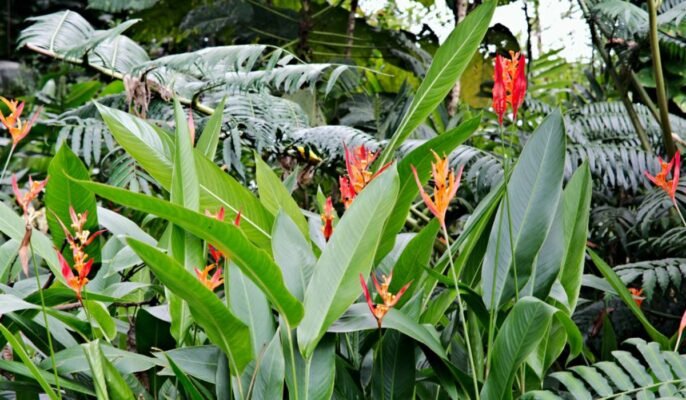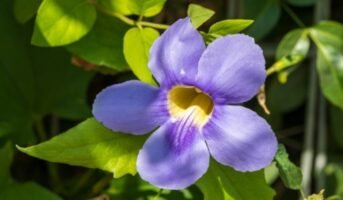Heliconia Psittacorum is grown as an ornamental plant all over the world. It can be used to add colour and beauty to your garden and can serve as the centrepiece of your yard. You can also grow Heliconia Psittacorum indoors if you want to enjoy it year-round. It is found in many different countries, and it produces beautiful flowers that are a joy to behold. So, read on to learn how to grow and care for Heliconia Psittacorum plants in your garden.
What is Heliconia Psittacorum?
Heliconia Psittacorum is a tropical plant that belongs to the Heliconiaceae family. It is one of the most common and beautiful plants in the world. It is native to the Americas, especially Central America, where it is commonly found in areas with high humidity and temperatures ranging from 25 to 35 degrees Celsius. Lobster claws, parakeet flower, toucan beaks, wild plantains, and false birds of paradise are common names for the genus. Their close resemblance to bird-of-paradise flowers (Strelitzia) has given them the name of false birds of paradise. They are collectively referred to as Heliconias.
Source: Pinterest
Heliconia Psittacorum: Key facts
| Botanical name | Heliconia Psittacorum |
| Common name | Parakeet Flower |
| Genus | Heliconia |
| Clade | Tracheophytes |
| Order | Zingiberales |
| Family | Heliconiaceae |
| Life cycle | Perennial |
| Mature size | Up to 3-4 m tall |
| Cultivation | Tropical America |
| Benefits | Medicinal Uses |
Heliconia Psittacorum: Physical description
Source: Pinterest
Heliconia Psittacorum can grow up to 3 metres tall. The flowers of this plant only last for a few days, which makes it one of the shortest-lasting flowers in the world. It comes in a variety of shapes and sizes. It also comes in different colours: green, white, yellow, red, orange or pink (depending on the species). Some varieties of Heliconia Psittacorum are very small, others will grow up to 4 m tall.
Types of Heliconia Psittacorum
There are many different varieties and cultivars of Heliconia Psittacorum to choose from. These include:
- Lady Di: It features creamy yellow flowers and dramatic red bracts.
- Andromeda: It has orange-red bracts with vibrant orange flowers.
- Choconiana: This cultivar also features orange flowers and orange-red bracts.
- Parakeet: It comes with yellow-and-red bracts and variegated foliage.
- Fuchsia: This cultivar has creamy yellow flowers and pink bracts.
When purchasing, make sure the botanical name is Heliconia Psittacorum if you want to be sure of buying this plant.
Heliconia Psittacorum: How to grow?
Source: Pinterest
Heliconia Psittacorum is a tropical plant that can be found growing in the canopy of trees in Central America. It is easy to grow, but it needs to be aware of its environment. Light and humidity are essential for its growth. Heliconias are also susceptible to pests such as mealybugs and scale insects.
Heliconias prefer warm temperatures around 26 degrees Celsius and should be kept in bright light. They need lots of moisture during their growing season and should be watered regularly throughout the day until they are fully grown. Once they start blooming, they will require less water than before because their leaves will be open more often during that time period.
How to grow Heliconia Psittacorum from rhizomes?
- If you purchase a Heliconia from a catalogue or online, you’ll probably receive a rhizome rather than a full-grown plant.
- Ideally, rhizome plants should be planted in a medium-sized pot of well-draining soil.
- You may be able to determine the soil line by looking at the rhizome. If there is any new growth, make sure it remains above ground.
- Heliconias are more susceptible to root rot when they are overwatered. So make sure you don’t overwater them.
- A new shoot may take a while to appear, and the old stem is likely to wither first, which is perfectly normal.
Heliconia Psittacorum: Care tips
Source: Pinterest
The plant can be grown indoors or outdoors. It prefers warm temperatures, between 16°C and 27°C, but it will tolerate cooler conditions as well. The soil should be moist but well-drained so that the roots do not rot. It requires full sunlight to grow well, so place your pot in a spot with plenty of sunlight throughout the day.
It is simple to take care of Heliconia Psittacorum. All you need to do is provide it with enough light, consistent irrigation, and fertilisation every few weeks with a balanced fertiliser that contains both nitrogen and phosphorus.
What are the uses of Heliconia Psittacorum?
Source: Pinterest
- Heliconia Psittacorum has been used as a folk medicine for centuries in some parts of Central America, South America and Mexico.
- It’s believed that this plant has medicinal properties because it contains alkaloids that act as antidiarrheal agents and anti-inflammatory agents.
- The majority of Heliconiaceae species are ornamental with exotic appearances. These tropical garden plants are characterised by lush green foliage and vibrant inflorescences.
- Landscape designers use Heliconias not only in outdoor gardens but also in low-light indoor gardens and window displays.
Is Heliconia Psittacorum toxic?
Heliconia Psittacorum is considered poisonous and if parts of the plant are ingested, it might lead to nausea, loss of appetite, and vomiting. So, if you do plant a Heliconia Psittacorum in your garden, make sure it’s out of reach of the kids and pets.
FAQs
What's the most effective way to care for Heliconia Psittacorum?
Heliconias need bright light and regular watering, but don't overwater them. Heliconias shouldn't stand in water, and the soil should almost dry out between waterings.
How are Heliconias used in homes?
The growth of Heliconias makes them a suitable choice for creating a screen between properties, especially in the summer.
Should Heliconias be pruned?
Heliconias do not require pruning, since they have pseudostems made up of rolled leaves, and their flowers arise from their tops.
Housing News Desk is the news desk of leading online real estate portal, Housing.com. Housing News Desk focuses on a variety of topics such as real estate laws, taxes, current news, property trends, home loans, rentals, décor, green homes, home improvement, etc. The main objective of the news desk, is to cover the real estate sector from the perspective of providing information that is useful to the end-user.
Facebook: https://www.facebook.com/housing.com/
Twitter: https://twitter.com/Housing
Email: editor@housing.com

